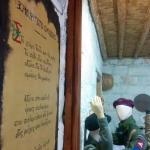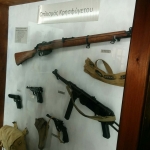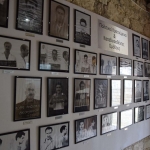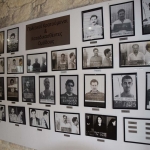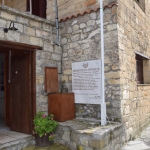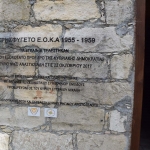Linos
Cyprus was acquaintance from the antiquity for the vines and the manufacture of good wines. An example constitutes Omodos that from the ancient years is been famous for the chosen grapes and its tasteful wines. According to the tradition, exceptional quality wine of Afami, that took the name from the mountain that is found in Easterly of the village, gave the reason, for the drunkard Sultan Selim B to conquer the island in order to it have this eminent wine on his own. The fact that the manufacture of traditional wine was acquaintance in Omodos from the ancient years is also testified by the medieval Linos of Omodos.
In the old ages, as technical means for pressing the grapes, for production of wine, they used the Linos (Mill for pressing of grapes).
Linos is found in small distance by the Monastery of Honest Cross-at Omodos and has an entrance manufactured from engraved arch, like the ones at the monastery. It is accommodated in an oblong, stone-build room that has length roughly 13 meters and width of 5 ½ meters, with level roof manufactured from loft. The floor of Linos is made with flagstones. In the interior and above the entry there is a shaped wooden storage place. In the northern side (right of the spectator) there is a line from vats, while in the southern side of (left of the spectator), they are placed there, some other vats and accessories. Between them there is a cauldron of old type, built from stone and bricks. In the room, in the intermediary of the lines made from the vats, the grapes pressing mechanism is found.
At the backside of Linos, at a level one-meter roughly from the floor, it is found the “tziathos”, a space where the grapes were unfolded and in later stage the bagasse. The internal sides of “tziathos” are covered with plaster.
Afterwards the pressing of grapes or later afterwards the grinding of grapes with the mill, the bagasse are placed in the vats for fermentation. (At the duration of fermentation the bagasse are always kept sunk in the vats because if they come at the surface and they remain there for some time exposed to air there is danger of being polluted and furthermore to become vinegar. For this reason at the top of the vat ” mazin” is placed and over this, crossed wooden bars are placed which press the “mazin” downwards with the help of heavy rock which is placed above them. After fermentation that lasts 16 – 25 days, the wine is placed in other clean vats, but the bagasses are placed in the “tziathos” to be pressed and give all the wine they have.
The floor of “tziathos” has a light bent, having a hole at the lowest level, from which the wine runs via medium channel in the vat that is half inserted in the earth and it is called “podosin”.
The operation of pressing is based on the system of lever of second type. It is constituted by the “Mouklo'” (Lever) – they are two big central wooden bars one above the other. One passing via means of “distyllon” (drivers) of “tziathos” is inserted in the “rizomoukla'” (reception) at the backside of the wall of Linos, which is also the backside of the “tziathos”. Upon the bagasses and below the elevated bars, level boards are placed and above that crossbars called “merkara'” are placed.
Above them a lever is placed called “mouskos”, that is useful for the pressing of the bagasses. In other end, in helical reception of the “mouklou” (lever) there is a vertical snail called “adrakti” fixed at the down part in boring block of stone of cylindrical form with diameter of one meter and height of 0.75 meter.
Two or even more individuals turn the “adrakti”, with the help of a lever that is found in the base of the “adrakti”, so the “mouklos” begins to descent and as result of this the bagasses are pressed. The pressure is increased as long as the counter clockwise rotation is continued. The block of stone rises progressively and remains hovering roughly 0.30 meter above the floor. After the bagasses are drained their volume is decreased, therefore the lever with the weight of block of stone goes downwards towards the floor.
Rotating the “adrakti” towards the clockwise direction does the releasing of the pressure.
Furthermore the wine that runs in “podosin” that is the vat, is transferred to other empty vats for storage, while the drained bagasses which are called “zivana”, are used for the production of “zivania”.
The Medieval Linos at Omodos has been declared to an Ancient Monument and constitutes property of Department of Antiquities, it has been repaired with sponsoring from the Institution Georgiou and Thelmas Paraskevaide and expenses of the Government of Cyprus.
Linos will be protected in the frames of policy for maintenance of our cultural heritage.
Editing of text: Panayiotis Socratous
Secretary of ecclesiastical committee

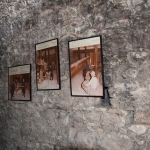
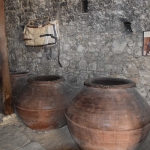
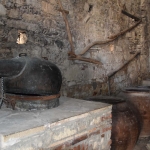
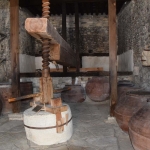
Village Square
One can get acquainted with the real Omodos not only by entering its narrow, graphic alleys but also when walking through the village’s large, picturesque plaza.
The plaza is also the place where the journeys of both foreign and local tourists ends. In it one can find the traditional coffee-houses and also many souvenir shops, recreation centres, and small taverns offered for a drink or even an enjoyable meal. Today’s increased interest of foreigners for Omodos lies exactly on the picturesque quality and the authenticity of its traditional character, elements that foreigners pursue and aspire to find in every place they visit.
Omodos’s plaza, which is perhaps the largest in Cyprus, dates back to 1910, is very graphic, has a range of 3000 sq. m., and is paved. Until 1968 it was paved, just like all of the village’s alleys were. Unfortunately, however, this beauty was thoughtlessly covered with asphalt, though the asphalt was again removed around 1987 and the appropriate configuration of the plaza was done, changing it as it was before.
It probably is unique, promoting both Omodos as well as Cyprus abroad.
Surrounded not just by beautiful, traditional houses with balconies but also encircled by the renowned mulberry trees, in front of the majestic and Historic Monastery of the Cross, bringing the people of everyday hard work together. This is where the people experience their joys and sorrows, the travails of struggling, the expectations and the optimism for the future.
In the hospitable and full of willingness coffee-houses, you can still see the inhabitants of Omodos spending their time playing both the traditional games (backgammon, “prefa”, “pilotta” -types of card games -and so many others) and even bridge and chess.
In the obliging restaurants one can enjoy well-made dishes and sweet wine. All these attractions of the plaza, along with the pleasant climate, offer a unique spectacle and relaxation to the visitor.
A few decades ago there also was a large kiln in the plaza, where the jars and other earthenware items were “baked”, their manufacturers bringing them for that exact purpose since Omodos, as the centre of the wine producing villages, was a large-scale consumer.
The plaza also had a huge, well-made fountain somewhere in its centre, as well as a mill where the wheat was ground. The inhabitants of Omodos share a dream of building them once again, fully restoring the former and unique picturesque quality of the plaza.
The plaza is the heart of Omodos. It is here that the tourism and the life of both locals and foreigners transform into their more substantial form. This is where they danced, still dance, and will keep on dancing and revel under the sounds of the violin and the lute ’till the morning hours.
Nowadays, many domestic and foreign tourist agencies -as well as the inhabitants of Omodos -organise celebratory events every year, as well as conventions, symposiums, dinners, productions of advertising spots, etc.
At the same time, in the context of preserving the rich, folkloric cultural heritage and tradition and the revitalisation of Omodos, it is -indeed -in this plaza that many Easter and other types of customs that are revived, such as the lighting of the “kouzalos” (meaning large firewood and referring to a bonfire), the singing of the Easter and the Virgin Mary’s lament, weddings, etc.
Do come in, to admire and enjoy the vast plaza of Omodos.
Editing of text: Panayiotis Socratous
Secretary of ecclesiastical committee
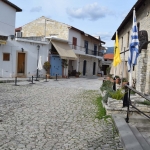
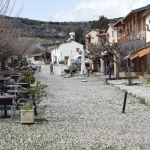
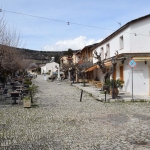
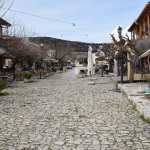
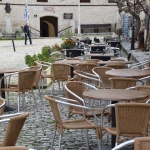
Hideout
Omodos’s contribution to the liberation struggles of our nation has been voluminous, significant, and expressed through deeds. Courageous and dynamic people could not be held back from the liberation struggle of 1955 – 1959. From the beginning until the end, many inhabitants of Omodos connected to and assisted the EOKA organisation in any possible way. Quite a few were the cases of combatant locals that were arrested and tortured by the British and several were those that were locked up in detention rooms.
Many wanted fighters from all over Cyprus passed through or stayed in Omodos, for small or large periods of time. Among them was also Grigoris Afxentiou. One effect of the rich activity developed by Omodos’s fighters, which were inspired by noble and high ideas that are common in all the free nations, was the creation of a hide-out in the house of Aristos and Maroulla Theodorou from Omodos, after instructions given by Grigoris Afxentiou. So, its construction started in October of 1956, with Charalambos Stavrou from Omodos as the foreman, the assistance of the owner’s close relatives and the sons of his father-in-law, Antonios G. Vouniotis, namely George and Andreas Antoniou from Omodos, and the Omodos group of the fighter Michalis Argyrou. It was made in such a way that its discovery was very difficult to begin with.
To enter it one had to go down a wooden ladder in the fireplace -after the hearthstone was removed -leading to an underground room that was the hideout. Ventilation was achieved through holes that the plaster-boards had.
The hideout of the guerrilla group of Nikos Spanos was dug under a room that was also used as a kitchen. It was spacious and somewhat comfortable, compared to the other ones that were made in the mountainous regions. On the other hand, the guerrillas stayed in Maroulla’s house most of the time rather than in the hideout.
That morning however, on the 21st of January 1957, security forces surrounded the village after receiving information and betrayal by outlanders. Police Inspector Barlow and Sergeant Stewart went to the house where the hideout was and knocked on the door. When they entered, they searched the house. In it were Maroulla, her sister Eleni, her mother Figoura, and Maroulla’s two little twins. The atmosphere around was calm. In one of the rooms, which was used as a kitchen, there was a fireplace with wood burning in it.
Although treason was involved, the British Forces had a hard time finding the entrance. After two hours had passed and the traitor -wearing a mask -was brought to the scene, he pointed the entrance with his hand.
The Police Inspector removed the hearthstone, behind which the opening of a hole and a wooden ladder appeared, leading to an underground room. At once the officer in charge asked those who were inside the hideout to come out. Some of those inside shouted: “Don’t shoot”. Then they came out of the hideout and surrendered. They had no other choice.
The ones arrested were:
- Savvas Stylianou Koullaris, 54 years old, a worker from Agios Theodoros.
- Georgios Palaiologou, employee in Nicosia.
- Kyriakos Kokkinos, 23 years old, from Palaichori
- Nikos Spanos, 22 years old, student.
- Ioannis Epameinondas, 24 years old, employee, from Pedoulas.
- Giorgos Loizidis, 32 years old from Chandria, blacksmith, later seceding to the British.
- Polykarpos Giorkatzis, employee from Palaichori.
- Antonis Kyriakou, 20 years old from Lysi.
- Aristos Theodorou, 25 years old, carpenter from Omodos, owner of the hideout.
Two of them, Giorkatzis and Spanos, were wanted for the price of £5.000.
After a search, a Bren machine gun, three Thompson submachine guns, a Smaizer machine gun, an Enfield gun, three revolvers, three clips (magazines), 700 bullets, and three grenades were found inside the hideout.
The case was sent to trial under the special judge Mr. Cyronel John. Their lawyers Stelios Pylidis, Antonis Indianou, and Lefkios Clerides represented the arrested persons in the trial. The eight were accused for possession of firearms, grenades, and explosives that were found inside the Hideout during the day of their arrest. The owner of the house were the Hideout was, A. Theodorou, was accused of harboring them and allowing them to construct a Hideout inside his residence.
Judge John, issuing his verdict, condemned the eight to life imprisonment and the owner to eight years.
After their arrest, all the furniture and the other items in the house were removed, the Hideout and the house were blown up.
